Norway spruce, planting and care guide
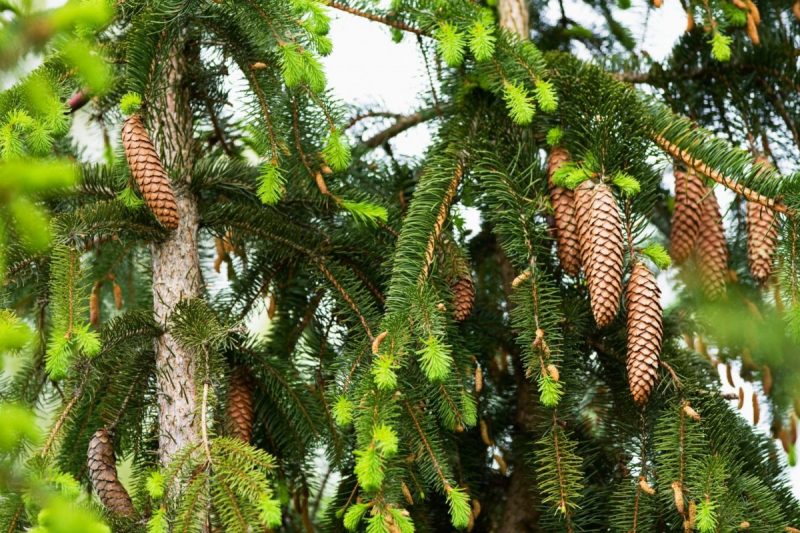
The spruce belongs to the genus Picea, a diverse group of resinous trees with a variety of species and varieties prized for their forestry and ornamental value. Their distinctive appearance, characterized by a straight, cylindrical trunk and persistent needlelike leaves, makes them a popular choice for landscaping and decoration. With an estimated lifespan of around 600 years, spruce trees can become majestic symbols of enduring beauty. But, their shallow root system, often with trailing branches, makes them susceptible to windthrow, a phenomenon where strong winds can topple them over. To mitigate this risk, careful site selection and proper soil preparation can help ensure the long-term health and stability of spruce trees.
Spruce species and varieties
Spruce (Picea abies)
The Norway spruce (Picea abies) is a widespread tree species, thriving in diverse habitats, from expansive forests to mixed woodlands with beech and fir, and even isolated pockets in alpine valleys. Its adaptability extends to park forests, parks, gardens, and yards, where it adds a touch of elegance to the landscape. The spruce’s resilience extends to both cold climates and wetlands, making it an adaptable and versatile tree species.
It has shallow rooting, the trunk has a characteristic reddish-brown bark, a pyramidal crown and a pointed tip. The branches are arranged in vertices that can be easily delimited in case of large specimens. The leaves are 1-2 cm long, stiff, mucronate and pungent. The male flowers are arranged in 1-2 cm red aments, developed on the previous year’s shoots. The female flowers are erect, yellowish-green or reddish, 4-6 cm long, situated on the tips of the branches..
Spruce cones persist on the tree branches until the following year after their formation. They are initially erect and cylindrical, gradually transitioning to a hanging orientation. These cones can grow up to 10-15 centimeters in length and appearing greenish or reddish when young. As they mature towards autumn, their scales become yellowish brown and stiff with blunt tips. The seeds within the cones are winged, with a brown coloration and a size of approximately 0.5 centimeters for the seed and 1 centimeter for the wing. The seedling stage of spruce trees features rosette-like cotyledons.
Varieties and ornamental forms of spruce:
- Picea abies var. columnaris;
- Picea abies var. carpatica;
- Picea abies var. europaea;
- Picea abies var. pyramidalis;
- Picea abies var. Inversa;
- Picea abies ‘Nidiformis’;
- Picea abies ‘Little Gem’, etc.
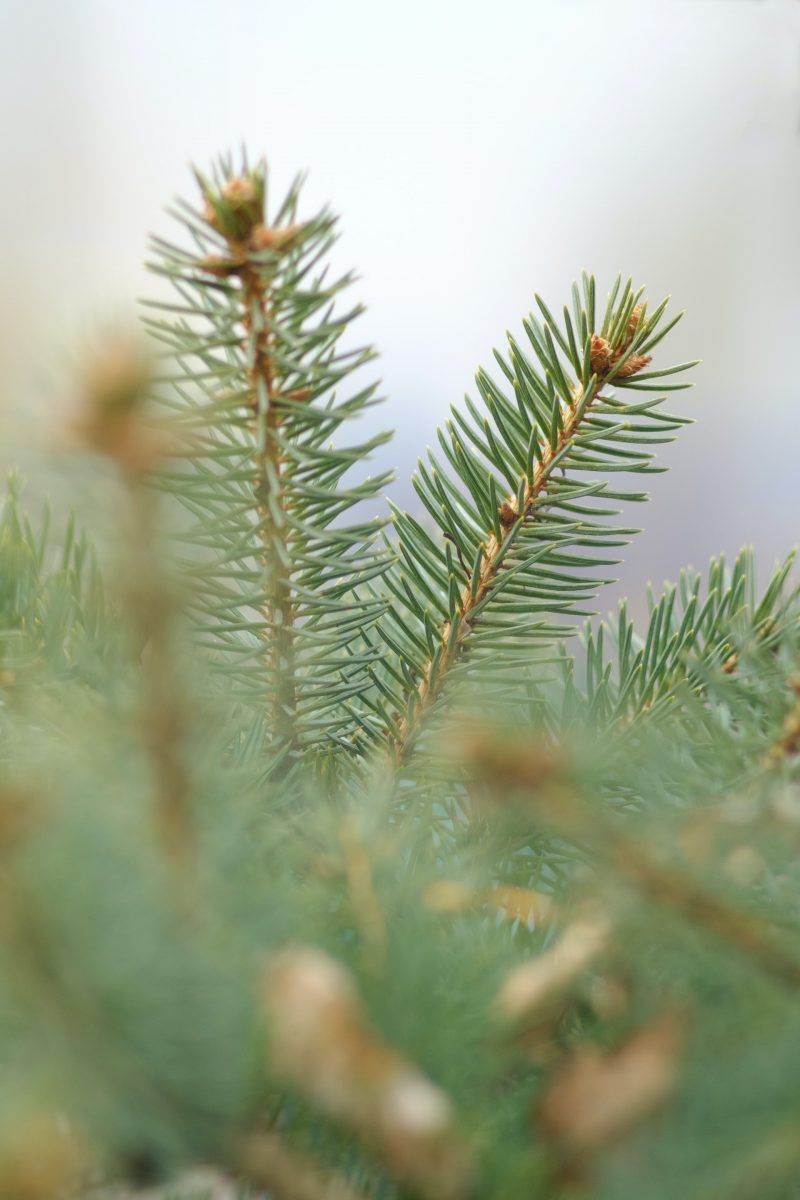
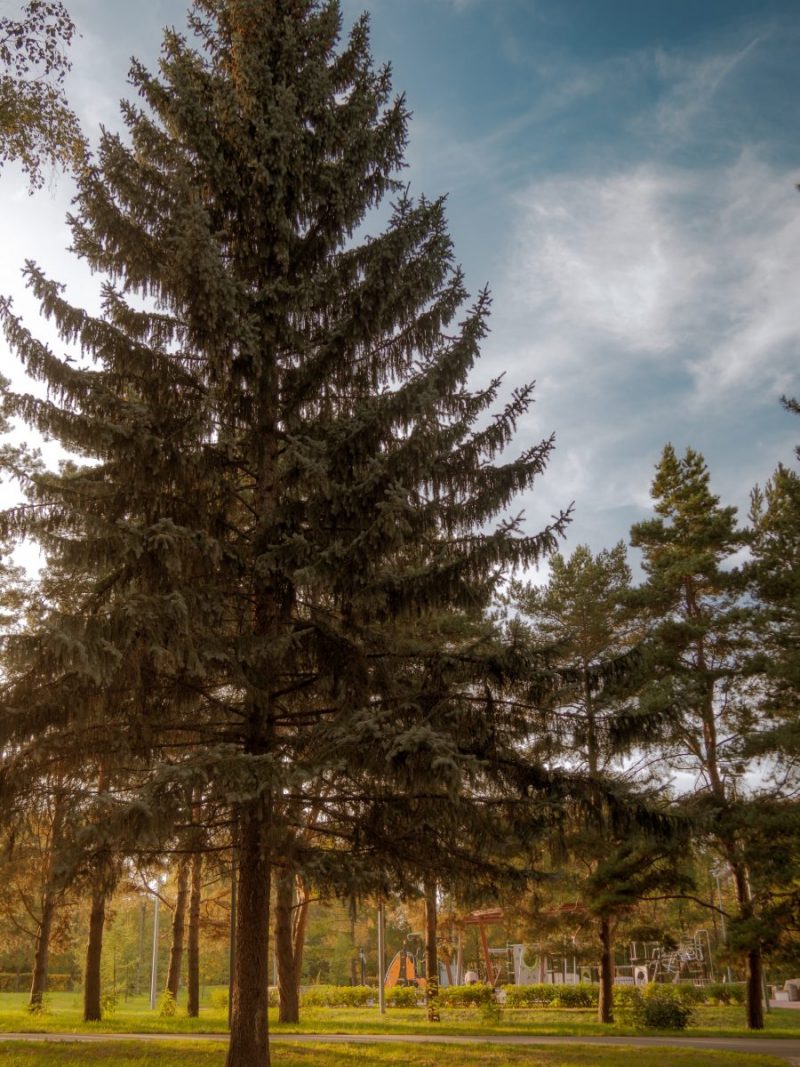
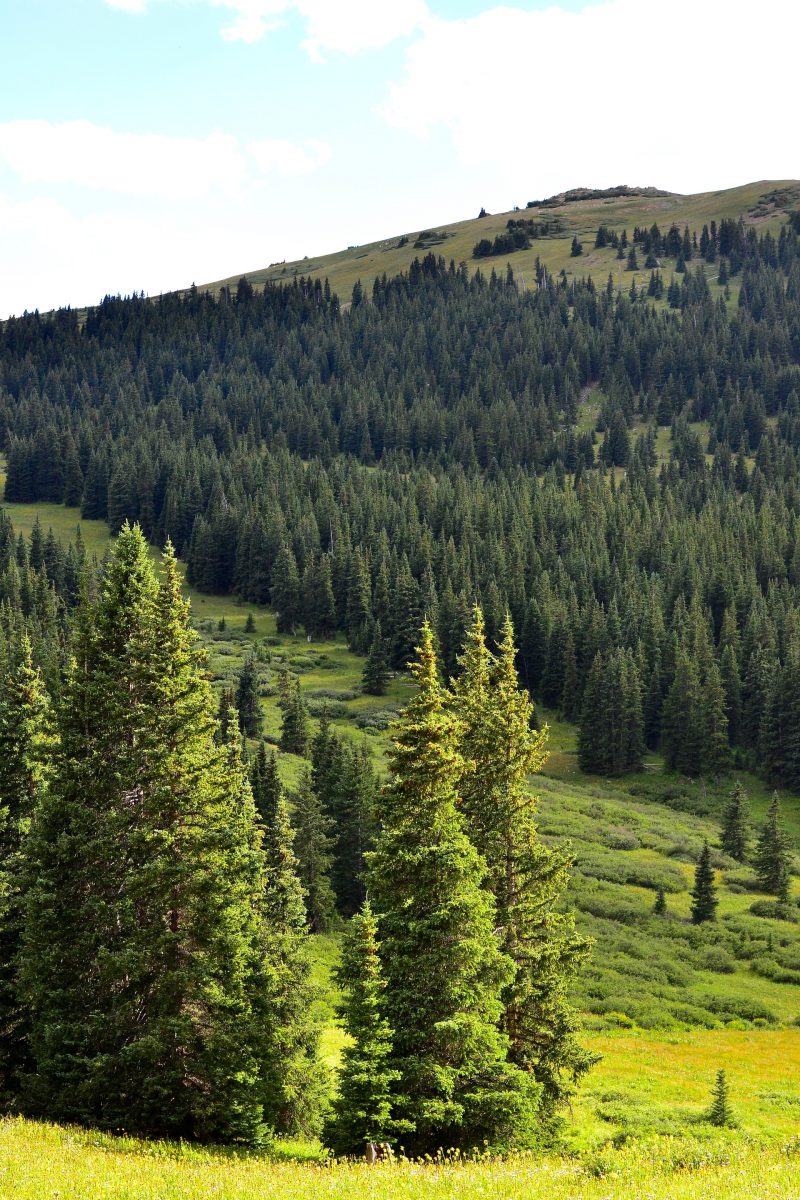
Oriental spruce or Caucasian spruce (Picea orientalis)
It is a species native to north-eastern Turkey and the Caucasus Mountains, cultivated in other areas for ornamental purposes. The Caucasus spruce usually reaches heights of approx. 40 m in the wild. It prefers shady places with high atmospheric humidity and deep, rich soil. Its aesthetic value is due to its narrow, pyramidal crown with branches close to the ground and short, straight, shiny needles.
There are several ornamental species of Caucasus spruce, among which we mention:
- Picea orientalis ‘Firefly’ (small and yellowish crown);
- Picea orientalis ‘Tom Thumb’ (small, compact and yellowish crown);
- Picea orientalis nana (small size and compact crown);
- Picea orientalis aurea (golden-yellow needles);
- Picea orientalis aureospicata (displaying a hint of golden hues on their needles as spring arrives).
Blue spruce (Picea pungens)
The blue spruce, a native of North American mountains, is a majestic conifer that can reach heights of up to 30 meters (occasionally even 50 meters). Its bark is a distinctive scaly and cracked texture, while its needles are a striking shade of blue or silver, sometimes even approaching whiteness. These needles are stiff and very prickly, adding to the tree’s captivating appearance. The blue spruce is remarkably adaptable, thriving in a wide range of soil conditions, humidity levels, and light exposures. Additionally, it exhibits remarkable resistance to air pollution, making it an ideal choice for ornamental cultivation in urban areas.
Among the varieties and varieties of blue spruce we mention:
- Picea pungens ‘Baby Blue’ (with blue-silver needles, pyramidal crown and ground-level branches);
- Picea pungens ‘Super Blue’ (with blue-silver needles, pyramidal crown and ground-level branches);
- Picea pungens ‘Glauca Globosa’ (small size, spherical crown and blue needles);
- Picea pungens var. glauca (with blue needles);
- Picea pungens var. argentea (with silver-coloured needles);
- Picea pungens var. kosteriana (with hanging branches);
- Picea pungens var. compacta (with compact crown).
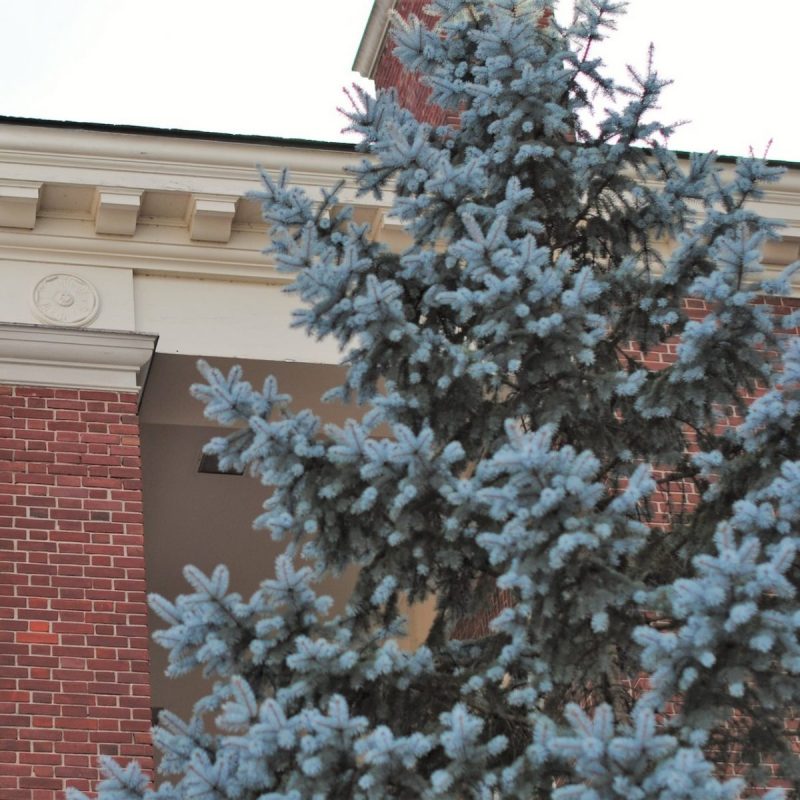
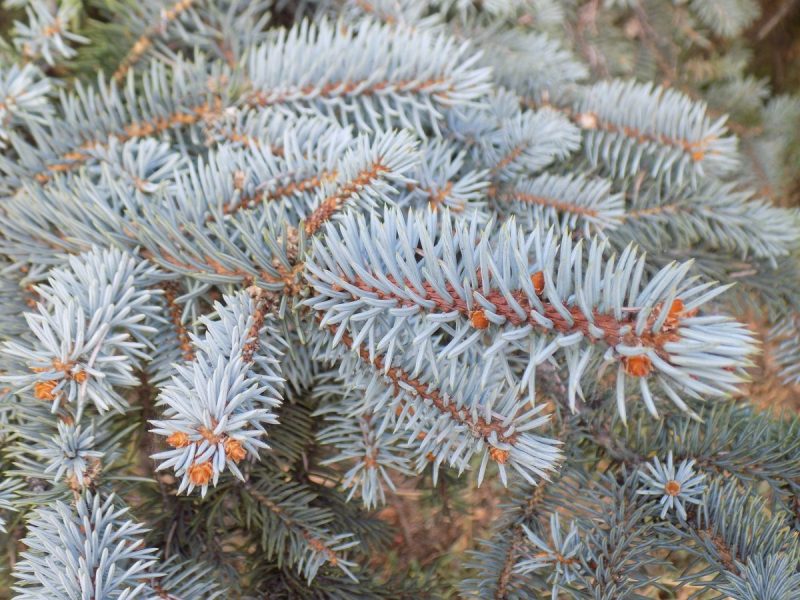
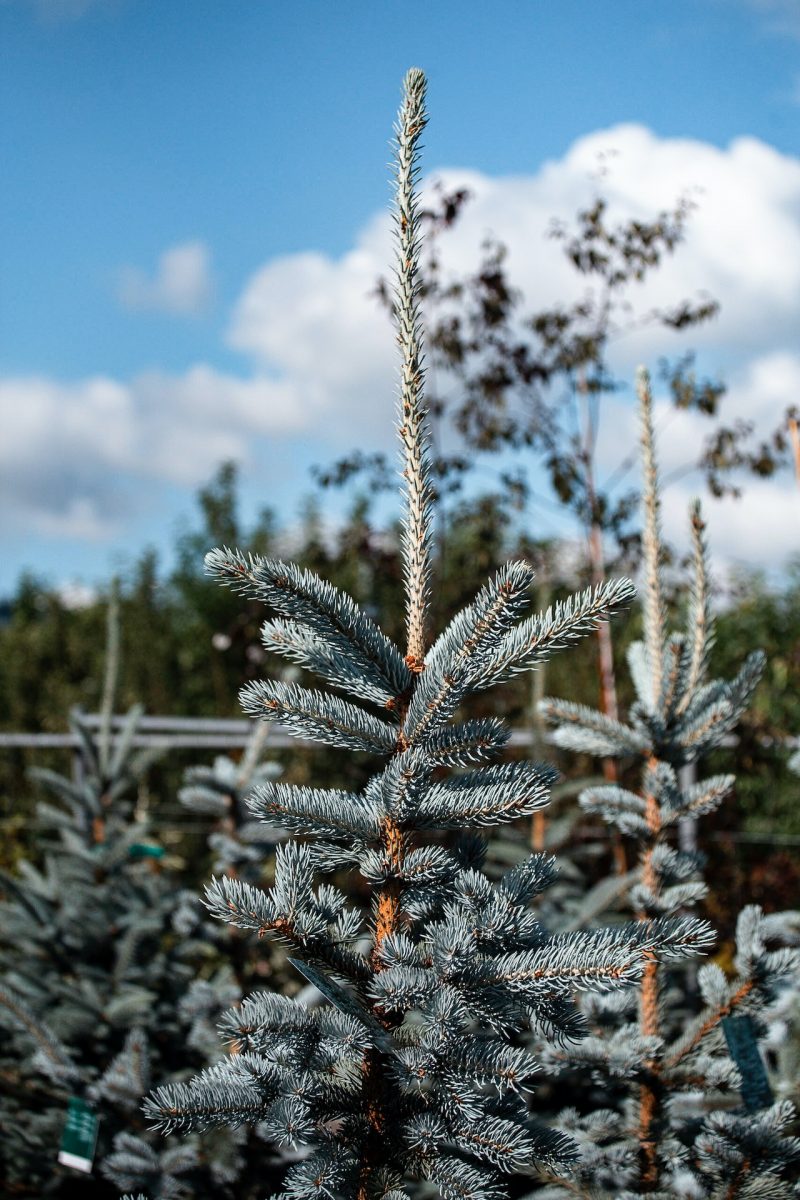
Engelmann spruce (Picea engelmannii)
This species of spruce, native to North America, is characterized by a narrow, conical crown and needle color ranging from green to blue-green. Remarkably adaptable, it thrives in a variety of environmental conditions, including drought, pollution, and partial shade.
Among the ornamental forms of Engelmann spruce we mention the following:
- Picea engelmannii ‘Bush’s Lace’ ;
- Picea engelmannii ‘Jasper’;
- Picea engelmannii ‘Blue Magoo’;
- Picea engelmannii ‘Hoodie’.
Sitka spruce (Picea sitchensis)
The Sitka spruce is a large tree (up to 40 m tall) native to North America. It prefers areas with atmospheric moisture and sufficient, abundant rainfall. It does not tolerate drought, dry air or pollution.
Among the ornamental forms of Sitka spruce we mention the following:
- Picea sitchensis ‘Aurea’;
- Picea sitchensis ‘Silberzwerg’;
- Picea sitchensis ‘Papoose’.
Pančić spruce or Serbian spruce (Picea omorika)
The Serbian spruce is a tree up to 30 m tall, native to the Balkan region. It is popular for its pyramidal or columnar habit, forming narrow crowns. It is resistant to drought, frost and pollution and is therefore planted for ornamental purposes even in urban environments.
Environmental conditions
The environmental requirements of spruce species vary depending on the specific species or variety, as well as the interplay of various abiotic factors. To provide a comprehensive understanding, the environmental requirements of Norway spruce (Picea abies) will be discussed in detail below.
Light. While spruce trees generally prefer dappled shade or semi-shade, they can also be successfully planted in full sun.
Temperature. Grows and develops best in cold areas with average annual temperatures between 4 and 7℃.
Soil. Spruce trees are generally adaptable to a wide range of soil types, including deep, rich, and poor soils. However, they thrive best in well-drained, aerated, and porous soils that receive adequate water. Excessive moisture can lead to fungal diseases and the development of root problems. While spruce trees are sometimes found in moist soils or even bogs, their growth and health are often compromised under these conditions.
Spruce trees typically accumulate a thick layer of fallen needles at their bases, which contributes to the acidification of the surrounding soil.


Care
The care requirements of the above species differ according to species and variety, but as well as the interplay of abiotic factors. In the following the care requirements of spruce (Picea abies) are described in particular.
Watering spruce trees should be done moderately, taking into account other environmental factors such as temperature and precipitation. Only water when the soil is visibly dry at the surface. Excessive watering should be avoided.
Fertilization. To ensure vigorous and dense growth, ornamental trees and young trees can be fertilized with specific fertilizers (both foliar and root).
Recommended products
-
You can find products on a different store
Change Store -
You can find products on a different store
Change Store -
You can find products on a different store
Change Store -
You can find products on a different store
Change Store -
You can find products on a different store
Change Store -
You can find products on a different store
Change Store -
You can find products on a different store
Change Store -
You can find products on a different store
Change Store -
You can find products on a different store
Change Store -
You can find products on a different store
Change Store -
You can find products on a different store
Change Store -
You can find products on a different store
Change Store -
You can find products on a different store
Change Store -
You can find products on a different store
Change Store -
You can find products on a different store
Change Store -
You can find products on a different store
Change Store -
You can find products on a different store
Change Store -
You can find products on a different store
Change Store -
You can find products on a different store
Change Store -
You can find products on a different store
Change Store -
You can find products on a different store
Change Store -
You can find products on a different store
Change Store -
You can find products on a different store
Change Store -
You can find products on a different store
Change Store
Pruning spruce trees for ornamental purposes involves shaping the crown according to design preferences. However, due to their monopodial growth habit, removing the apical meristem (growing tip) is not advisable. Regular removal of dead and weak branches is essential to maintain the tree’s health and shape.
Recommended products
-
You can find products on a different store
Change Store -
You can find products on a different store
Change Store -
You can find products on a different store
Change Store -
You can find products on a different store
Change Store -
You can find products on a different store
Change Store -
You can find products on a different store
Change Store -
You can find products on a different store
Change Store -
You can find products on a different store
Change Store -
You can find products on a different store
Change Store -
You can find products on a different store
Change Store -
You can find products on a different store
Change Store -
You can find products on a different store
Change Store -
You can find products on a different store
Change Store -
You can find products on a different store
Change Store -
You can find products on a different store
Change Store -
You can find products on a different store
Change Store -
You can find products on a different store
Change Store -
You can find products on a different store
Change Store -
You can find products on a different store
Change Store -
You can find products on a different store
Change Store -
You can find products on a different store
Change Store -
You can find products on a different store
Change Store -
You can find products on a different store
Change Store -
You can find products on a different store
Change Store
Planting spruce trees should be done during the spring or fall, with the best time being early spring, just after snowmelt. For successful planting, it is recommended to dig a hole of the appropriate size to accommodate the roots comfortably. The roots should be spread out loosely and covered with soil to the level at which they were previously buried. A specific granular fertilizer can be added to the planting hole to provide nutrients for the tree’s growth. After planting, the soil around the seedlings should be well-tilled and thoroughly watered.
Propagation. Spruce trees can propagate relatively easily through seed germination. Seeds mature in October-November and are naturally dispersed by wind until spring, due to their light, winged structure. If sown in fertile soil (either in open fields or sheltered areas), the seeds typically sprout within a few weeks (possibly a month) of sowing. After 1-3 years, the seedlings can be transplanted to a different location with wider spacing between plants.
Recommended products
-
You can find products on a different store
Change Store -
You can find products on a different store
Change Store -
You can find products on a different store
Change Store -
You can find products on a different store
Change Store -
You can find products on a different store
Change Store -
You can find products on a different store
Change Store -
You can find products on a different store
Change Store -
You can find products on a different store
Change Store -
You can find products on a different store
Change Store -
You can find products on a different store
Change Store -
You can find products on a different store
Change Store -
You can find products on a different store
Change Store -
You can find products on a different store
Change Store -
You can find products on a different store
Change Store -
You can find products on a different store
Change Store -
You can find products on a different store
Change Store -
You can find products on a different store
Change Store -
You can find products on a different store
Change Store -
You can find products on a different store
Change Store -
You can find products on a different store
Change Store -
You can find products on a different store
Change Store -
You can find products on a different store
Change Store -
You can find products on a different store
Change Store -
You can find products on a different store
Change Store
Diseases and pests
Diseases include wood-rot caused by xylophagous fungi, wood cancer, as well as fungal diseases that cause needle blight or drying of the leaf blades (including rust). Insect pests that cause damage to spruce are: Hylobius abietis, black arches or nun moth, Pristiphora abietina, Rhyacionia buoliana (the pine shoot moth), scale, aphids, Cydia strobilella (the spruce seed moth), Megastigmus strobilobius, and European spruce bark beetle.
Early detection of diseases and pests is crucial for the well-being of spruce trees. Regular visual inspections are essential, but supplementary monitoring methods like sticky boards, traps, and pheromone traps can be employed to enhance detection capabilities. If a pest or disease infestation is detected, targeted treatment with appropriate insecticides and fungicides is recommended to address the issue effectively.
In addition:
- Because the needles of spruce trees fall shortly after the tree is cut down, this species is not suitable for Christmas tree decoration (indoors);
- In the forest, seedlings are often observed growing on decaying stumps. These seedlings come from seeds that have fallen and germinated in the same spot;
- Young spruce trees can grow up to 1 meter in height each year (sometimes even more in optimal growing conditions);
- Spruce wood has many uses, including construction, joinery, the manufacture of laminated products (PFL, MDF), the paper industry, etc.;
- Certain spruce trees produce high-quality resonant wood, which is used in the manufacture of musical instruments and in the aerospace industry;


















































































































































































































































































































































































































































